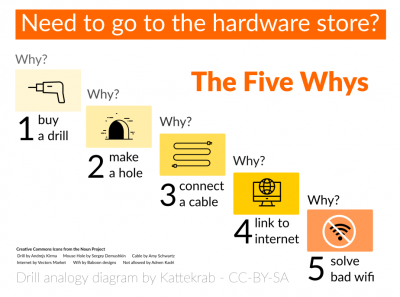Five Whys (5 Whys)
Get past the symptoms of a problem to the root cause
Jeremy Brown
What Is Five Whys (5 Whys)?
The "Five Whys" is a way to figure out what causes a problem. You keep asking "why" until you find the real reason. It was made up by Taiichi Ohno at Toyota.
Why Do Five Whys (5 Whys)?
The Five Whys technique is a useful tool for identifying the root cause of a problem. It can help teams get to the bottom of an issue quickly and efficiently, leading to more effective solutions that address the underlying cause rather than just treating symptoms. By asking "why" multiple times, you can uncover deeper insights and gain a better understanding of the factors at play. Additionally, using the Five Whys encourages a culture of continuous improvement and problem-solving within an organization.
Here's an example problem: the car won't start.
- Why? – The car battery is dead.
- Why? – The car alternator isn't working.
- Why? – The alternator belt broke.
- Why? – The alternator belt was old and worn out.
- Why? – The car wasn't maintained as recommended. (This is the real cause.)
You can ask "why" up to five times (or more) to find the real reason for a problem. It's important to avoid guessing and follow the cause-and-effect chain to the root cause. In this example, the fifth "why" shows a problem with a process or behavior that needs to be fixed.
The five-whys approach is about finding the root cause of a problem. It's important to look for a process that's not working well or not there at all. Sometimes people will say the problem is not enough time, money, or resources. But we can't control those things. So, we should ask why the process failed instead of just asking why.
How to do Five Whys (5 Whys)?
To use the 5 Whys:
- Get a Team Together: Get people who know about the problem and someone to keep everyone on track.
- Figure Out the Problem: Look at the problem and write it down so everyone can see it.
- Ask "Why?" the First Time: Ask why the problem is happening, but use facts instead of guesses.
- Ask "Why?" Four More Times: For each answer, ask "why?" four more times, based on the last answer.
Look at Five Whys (5 Whys)
Links we love
Check out these great links which can help you dive a little deeper into running the Five Whys (5 Whys) practice with your team, customers or stakeholders.
